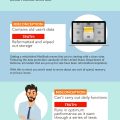Sometimes your MacBook makes a loud noise or produces whirring sounds while heating up. Therefore, people are surprised and wonder why MacBook gets so hot.
This usually happens when you run too many applications or processes at once. Overheating can also be caused by too many browser tabs or by covering the MacBook’s vents.
Please don’t worry if it still seems confusing to you. This guide explains why MacBooks heat up and how to solve them. Surely, in the end, you’ll be able to know why your MacBook gets so hot.
So let’s jump into it.
Why Does MacBook Get So Hot? Common Reasons
1. Too much stress on your CPU
Your Mac’s processor cores work harder, leading to heat build-up and overheating. Perhaps you have noticed that your Mac is becoming slower when you open a browser or a video editing application.
These apps often run multiple processes, which can slow your Mac’s processing speed and cause overheating.
2. High ambient temperature
The temperature limits that Macs can withstand are varied. Extreme heat can cause damage to your computer. Apple recommends using your Mac in temperatures between 50 deg n 95degF (10deg and 35degC).
Direct sunlight can cause damage to your MacBook and reduce its lifespan.
3. Fans that are blocked or clogged
Your warm blanket could be making your MacBook Pro run hot. We all love to use our Macs as a bed. If your Mac has fans, the vents on the back of your Mac are used to remove warm air from the chassis components.
If the vents become blocked or clogged, the warm air will not be able to travel where it needs to when the fans kick in.
4. Malware
Malware can be hard to find on Macs, but it can hide a lot of intense processes, heating your Mac. Backdoors, browser hijackers, and adware are all common threats to Macs. If your Mac is heating up, check it for these issues.
5. Frozen or unresponsive apps
Apps can sometimes freeze or misbehave; those spinning wheels appear on Macs. Even though an app may not respond, it still consumes Mac’s memory. Your Mac will allocate lots of CPU resources to fix laggy apps, which heats up the processor.
The first reason is the most popular. The other four are important too. Moving your MacBook from your lap onto a flat surface can help keep it cool and decrease the risk of overheating. Dust can also cause problems with cooling fans if the Mac is older than a few years.
You may be surprised at how much dust can get into your Mac’s ventilation holes if it is older than a few years.
How to cool your MacBook if it is too hot
The cause of your MacBook getting too hot will determine your actions. We’ll start with the CPU overheating as it is the most common reason for overheating.
1. You can check CPU usage.
You should first check your Mac’s CPU usage to see if it is overheating. To do this, you don’t need third-party apps. I’ll show how Activity Monitor can check your CPU load.
- Open Activity Monitor (Finder > Application > Utilities).
- Click on the CPU tab.
All your processes and apps will be listed, starting with the most CPU-intensive to the lowest.
You can quit these intensive apps easily by selecting the process or the app you wish to quit and clicking the “X” button. Click the “X” button to confirm that you want to close the app.






